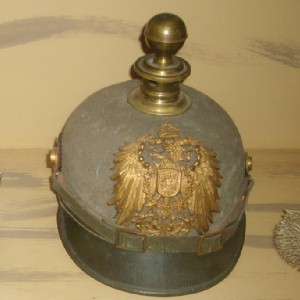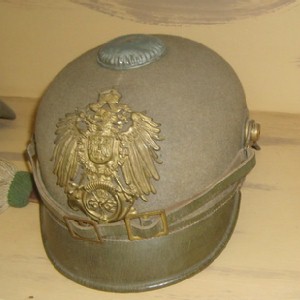|
The new helmet varied from the previous army
Pickelhauben in several ways. Rather than being made of blackened leather
the 1900 helmet was made of field grey pressed
felt. This was cheaper to produce and offered more of a camouflage
appearance than the earlier Pickelhaube.
The front and rear peaks were made of green
leather. The peaks did not have metal edging. Unlike the leather
Pickelhaube the felt helmet had no rear spine.
The spike was of yellow metal with a
rounded base. Officers helmets were not distinguished by fluted
spikes or cruciform bases but did have a "pearl ring" around the
base of the spike. The spike was intended to be removed in action and replaced
with a small round grey metal cap that screwed in its place. When
not in use the metal cap could be screwed to the underside of the
helmet.
As the new East Asian
Occupation Brigade was an imperial unit rather than one nominally
individual state authority as the Expeditionary Corps had been, the
new helmet had only
imperial insignia. This insignia took the form of an imperial eagle
with downswept wings
in yellow metal, which was intended to be removed in action.
The helmet had an imperial cockade
under the right hand chinstrap boss and no cockade at all on the
left side where the state cockade had previously been displayed.
The chinstrap for other ranks was of
usually grey green leather with two yellow metal buckles to adjust its length.
Some surviving examples have natural brown leather chinstraps. Officers and senior NCOs had yellow metal chinscales on parade. As with most uniform items, officers
usually purchased privately made Pickelhauben with better quality
materials.
There were a few distinctions for
arms of service. The artillery wore a helmet with a ball instead of a spike ("Kugelhelm").
The
pioneers and staff officers had a white metal spike, eagle and chinscales (see below for
Arm
of Service variations).
The Jager-zu-Pferd wore a hunting horn
below the imperial eagle on their helmets.
The East Asian Jäger
(disbanded in 1901) and Train units wore a similar grey felt shako
("Tschako")
with the same eagle and Imperial cockades as the East Asian
Pickelhaube with an oval imperial cockade on the front.
Helmet covers were not worn with the 1900 helmet. With the the spike
and imperial eagle removed for action, the helmet had a plain low
profile field grey appearance without the need for a cover.
|

1900 East Asian Artillery Kugelhelm
Note the ball replacing the spike for the artillery

1900 East Asian Jäger-zu-Pferd Pickelhaube
Note the post horn below the Imperial eagle and the screw cap replacing the spike for active service.
Photos taken at the Fort de la Pompelle
Museum near Rhiems, France
by Khukri and originally shown on the
Pickelhaubes Forum |